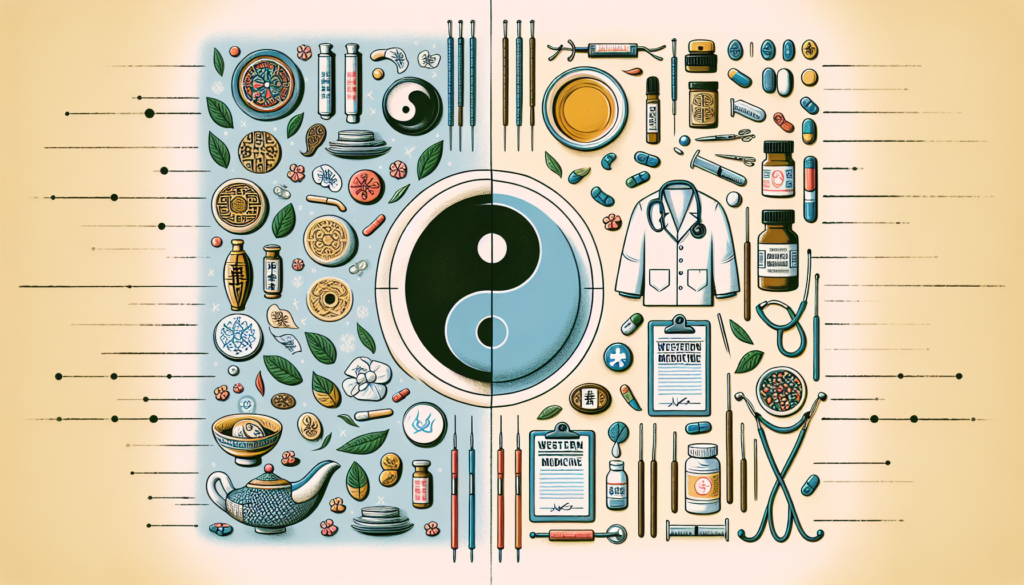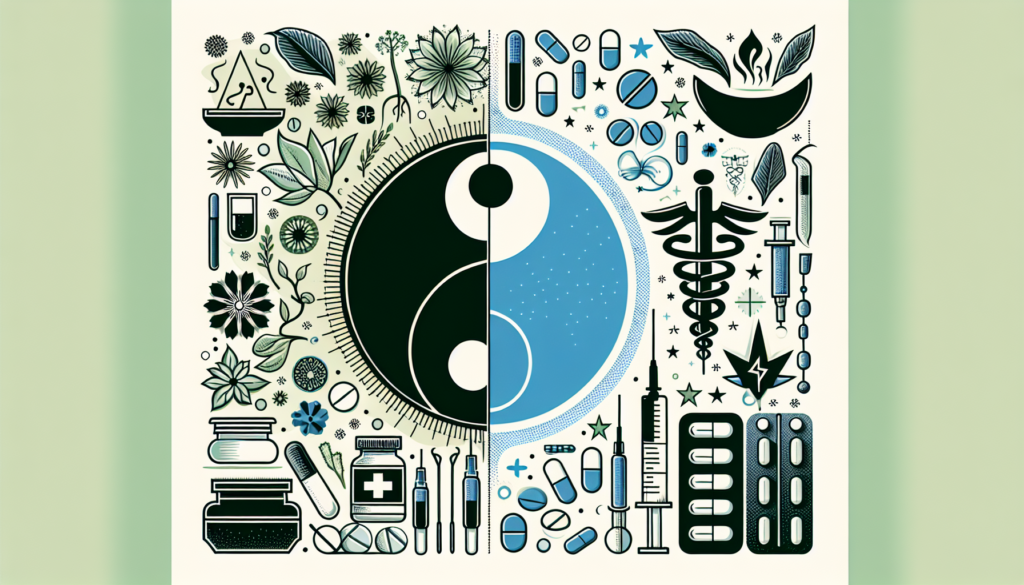Are you curious about the differences between traditional Chinese medicine and Western medicine? In this article, we will explore the fundamental disparities between these two approaches to healthcare. Traditional Chinese medicine, rooted in ancient practices and philosophy, takes a holistic approach to healing by considering the balance between the body, mind, and spirit. On the other hand, Western medicine focuses primarily on diagnosing and treating specific diseases using evidence-based practices and pharmaceutical interventions. Join us as we delve into the distinct characteristics and perspectives of these two fascinating medical systems.

Treatment Approach
When it comes to the treatment approach, traditional Chinese medicine (TCM) takes a holistic approach, considering the whole person rather than just the symptoms or specific body parts. This stands in contrast to the reductionist approach of Western medicine, which tends to focus on specific organs or systems. TCM believes that the body is a complex interconnected system and that everything within it is interconnected. As such, TCM aims to restore balance and harmony to the body as a whole.
TCM also focuses on preventive measures rather than reactive ones. It emphasizes the importance of maintaining good health and preventing diseases before they occur, rather than solely treating them after they have already manifested. This proactive approach can help individuals stay healthy and address imbalances before they become significant health issues.
Furthermore, TCM recognizes the uniqueness of each individual and their specific health needs. Treatment is highly individualized, taking into account factors such as age, constitution, lifestyle, and emotional state. Rather than applying standardized protocols, TCM practitioners tailor their treatments to the specific needs and characteristics of each patient. This personalized approach aims to achieve optimal results by addressing the root cause of health issues.
Understanding of Health and Disease
Traditional Chinese medicine has a unique understanding of health and disease that differs from the Western medical model. In TCM, health is seen as a state of balance and harmony within the body, while disease is viewed as an imbalance or disharmony. To maintain good health, TCM believes that the body’s vital energy, known as “qi,” must flow smoothly and be in balance. Qi functions as the life force or energy that powers the body’s functions.
In TCM, the concept of yin and yang is also central to understanding health and disease. Yin and yang are opposing forces that exist in everything in the universe, including the body. Health is achieved when these forces are in harmony and balanced. Disease occurs when there is an imbalance, excess, or deficiency of yin or yang within the body.
The Five Elements Theory is another important concept in TCM. It categorizes the body’s organs and functions into five elements – Wood, Fire, Earth, Metal, and Water. Each element corresponds to specific organs and qualities, and an imbalance in any of these elements can result in health issues.
TCM also believes in the existence of a network of meridians, or energy pathways, throughout the body. These meridians are believed to be responsible for the flow of qi and the balance of yin and yang. When there is a blockage or disruption in these meridians, it can lead to imbalances and health problems. Diagnosis and treatment in TCM often involve assessing the state of these meridians and restoring their proper flow.
Diagnosis Methods
In traditional Chinese medicine, several methods are used for diagnosis, each offering valuable insights into the patient’s health. Observation and examination play a significant role as the practitioner assesses the patient’s physical appearance, including the skin, complexion, eyes, and overall body structure. These observations can provide clues about the individual’s internal health.
Pulse diagnosis is another central diagnostic technique in TCM. By feeling the pulse at various positions on the wrist, a skilled practitioner can detect subtle changes in the pulse quality, rhythm, and strength. Each position corresponds to specific organs and gives insights into the state of the body’s energy and overall health.
Tongue diagnosis is also widely used in TCM diagnosis. The tongue is considered a mirror of the body’s internal organs and systems. Practitioners examine the tongue’s color, shape, coating, and other characteristics to identify imbalances or disharmonies within the body.
TCM diagnosis also involves categorizing patients into different syndromes based on the combination of their symptoms, medical history, and diagnostic findings. These syndromes provide a framework for understanding the underlying imbalances and inform the treatment approach.
Treatment Techniques
TCM offers a range of treatment techniques to restore balance and promote healing in the body. Acupuncture is one of the most well-known and widely practiced techniques in TCM. It involves the insertion of thin needles into specific points on the body to stimulate the flow of qi and restore balance. Acupuncture has been used for thousands of years to alleviate pain, promote healing, and address a wide range of health conditions.
Herbal medicine is another cornerstone of TCM. Chinese herbal formulations, made from a combination of herbs, are prescribed to address imbalances and promote healing. These herbal remedies are believed to work in synergy to restore the body’s natural balance. Chinese herbal medicine generally takes into account the specific needs of the individual and their unique patterns of disharmony.
Moxibustion is another technique used in TCM, where dried mugwort herb is burned near specific acupuncture points to warm and stimulate the flow of qi. This technique is often used to address conditions related to cold or stagnant energy.
Cupping therapy involves creating suction on the skin through the use of glass cups, which helps to stimulate blood flow, release tension, and promote healing. This technique can be used to address muscle pain, respiratory conditions, and other health issues.
Tuina massage is a form of Chinese therapeutic massage that involves various techniques to stimulate the flow of qi and promote healing. It can be used to address musculoskeletal issues, promote relaxation, and support overall well-being.
Dietary therapy is an essential aspect of TCM treatment. TCM practitioners assess an individual’s dietary habits and make specific recommendations to support their health and address imbalances. Foods are categorized according to their energetic properties and their effects on the body, and a personalized dietary plan is provided to enhance healing and prevent further imbalances.
Pharmacology and Medications
In traditional Chinese medicine, a range of substances is used for therapeutic purposes. Herbal formulations are a significant component of TCM pharmacology. These formulations typically consist of a combination of various herbs, each chosen for its specific properties and effects on the body. The combination of herbs is believed to enhance efficacy and minimize side effects.
Animal products are also used in some traditional Chinese medicine formulations. These include substances such as deer antler, turtle shells, and dried insects. These animal products are believed to have specific medicinal properties and are used in carefully regulated doses.
Mineral remedies, which include substances like pearls, cinnabar, and realgar, are also used in TCM. These minerals are believed to have therapeutic effects when used appropriately and in controlled doses.
In addition to herbal formulations, traditional medicine patent drugs are also used in TCM. These are commercially prepared formulas that come in the form of pills, capsules, or powders. They are convenient to use and often prescribed for common conditions.
Safety and Side Effects
One significant advantage of traditional Chinese medicine is its minimal side effects. When used correctly and under the guidance of qualified practitioners, TCM treatments are generally safe and well-tolerated. The use of natural substances, personalized treatments, and emphasis on balance and harmony helps minimize the risk of adverse reactions.
However, it is important to note that TCM can interact with Western medications. Some herbs and formulations may have interactions with specific medications, which is why it is essential for individuals to inform their healthcare providers about any TCM treatments they are undergoing.
Another aspect of safety in TCM is contamination and quality control. With the increasing demand for traditional Chinese medicine worldwide, there have been concerns about the quality and purity of some herbal products. To ensure safety and quality, it is essential to obtain TCM treatments from reputable sources and trained practitioners who adhere to strict quality control measures.
Integration with Western Medicine
The relationship between traditional Chinese medicine and Western medicine can be seen as complementary or alternative, depending on the perspective. Many individuals use TCM alongside modern Western medical treatments to support their health and address specific conditions.
In some cases, TCM and Western medicine practitioners work collaboratively to provide comprehensive care. This integrative approach takes advantage of the strengths of both systems to optimize patient outcomes. For example, in some hospitals, TCM practitioners work as part of the healthcare team and offer TCM treatments in conjunction with conventional medical treatments.
The integration of TCM with Western medicine is also supported by evidence-based practice. There is growing scientific interest in studying the efficacy and safety of TCM treatments. Research is being conducted to explore the mechanisms of action of TCM interventions, identify active compounds, and evaluate their effectiveness in controlled clinical trials. This evidence-based approach helps provide a clearer understanding of the benefits and limitations of TCM treatments.
Education and Training
Becoming a qualified traditional Chinese medicine practitioner requires extensive education and training. The length of training varies across different countries and regions, but it generally involves several years of dedicated study.
During their training, TCM practitioners learn about TCM theory, diagnosis methods, treatment techniques, herbal medicine, and other aspects of TCM practice. They also gain hands-on experience through clinical rotations and apprenticeships, where they learn from experienced practitioners.
Credentialing and licensing for TCM practitioners vary by country. In some regions, TCM practitioners must meet specific educational requirements and pass licensing examinations to practice legally. Continuing education is also encouraged to ensure that practitioners stay up-to-date with the latest developments and advancements in the field.

Cultural and Philosophical Differences
Traditional Chinese medicine has its historical roots in ancient China and is deeply influenced by the country’s cultural and philosophical traditions. TCM’s holistic approach to health and disease reflects the broader philosophical outlook of Chinese culture.
TCM places a strong emphasis on the interconnectedness of the individual with nature and the environment. It recognizes that individuals are an integral part of a larger whole and that their health is influenced by external factors such as seasons, climate, and lifestyle. This holistic philosophy recognizes the importance of balance and harmonious interactions between individuals and their surroundings.
In TCM, there is also a strong emphasis on individual responsibility for health. Individuals are encouraged to take an active role in maintaining their well-being through lifestyle choices, such as nutrition, exercise, and stress management. TCM views health as a dynamic balance rather than a mere absence of disease.
Global Health and Beyond
Traditional Chinese medicine has gained popularity not only in China but also worldwide. Many people from different cultural backgrounds seek out TCM treatments as an alternative or complementary approach to Western medicine. TCM clinics and practitioners can now be found in various countries around the world.
The integration of TCM into national healthcare systems is also occurring in some regions. Countries like China, Singapore, and Taiwan have established policies to promote the integration of TCM with Western medicine. This includes collaborations between TCM and Western medicine practitioners, research initiatives, and the development of guidelines for TCM practice.
Research and collaboration between TCM and Western medicine are important for further understanding and development of TCM strategies. While some controversies and criticisms exist about certain aspects of TCM, ongoing research aims to address these concerns and improve the scientific understanding of TCM treatments. Collaboration between practitioners, researchers, and policymakers can help bridge the gap between different medical systems and improve healthcare outcomes for patients globally.



